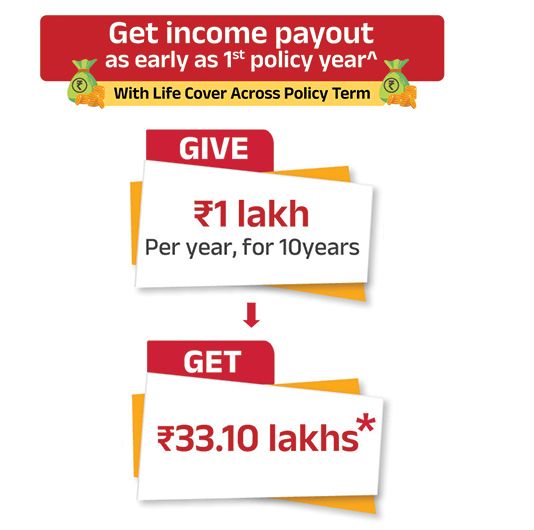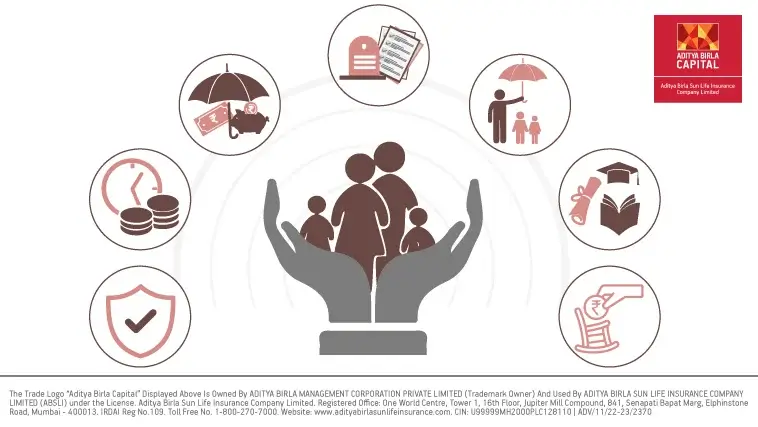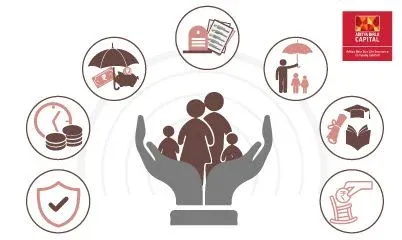Aditya Birla Sun Life Insurance Company Limited
5 Myths About Personal Finance And Their Reality

Plan Smarter, Live Better!

Thank you for your details. We will reach out to you shortly.

Currently we are facing some issue. Please try after sometime.


- Table of Contents
Personal finance is an essential life skill. And although it is not taught as a part of elementary school curriculums, it is never too late to learn - and unlearn - what personal finance is all about.
If you’re like most people, over the course of your adult life, you may have picked up certain biases, opinions and ‘facts’ about managing money and making investments from various sources around you. Like your favourite personal finance blog, your local newspaper, your neighbour’s free advice, and even from your own parents.
Most of these tidbits of information may be authentic and correct, but some details passed on may be inaccurate and far from the truth. The interesting thing is that these false bits of information often sound so genuine that it’s easy to believe they're true.
Today, we're going to be looking at some myths about personal finance, and decode the truth behind these myths.
Myth #1: Owning a home is better than renting
Most of the folks in our parents’ and grandparents’ generations believed in buying a house to ‘settle down in,’ as they put it. This bit of financial advice has been passed on to the next generations too, which is why owning a house is still considered by many a symbol of financial stability. Renting, on the other hand, is looked at as merely a stepping stone to owning a house some day in the future.
So, the rent vs buy dilemma is at the heart of financial planning for many people.
The truth behind the myth:
During the two decades from 1995 to 2015, real estate investments in India appreciated significantly and delivered lucrative returns.[1] But after 2015, the real estate market in the country flattened out and has since become stagnant. It is no longer what it once used to be.
It is ill-advised to expect the same kind of returns our parents’ or ancestral homes fetched. Furthermore, in many cases, the overall cost of renting a house may be lower than the cost of buying one. So, the bottom line is that owning a home may not always be better than renting.
You need to compare the costs of the two options with regard to your income and your financial situation before you make a decision, rather than indiscriminately following the myth.
Myth #2: Gold is a safe investment option
Like real estate, gold has also held a special place in the investment portfolio of most Indian homes. Part of this can be traced back to the fact that gold also holds a great deal of sentimental value for Indians. But when it comes to financial planning, you need to look beyond the emotional and sentimental aspects, and take your decisions objectively.
One of the key reasons gold was (and still is) considered a safe asset is because it is one of the few investments that gain value when the stock markets fall. But this alone is not sufficient to cement its place as a safe haven asset any longer.
The truth behind the myth:
Back in the day, when investment options were quite limited, it made some sense to hold gold in your portfolio to cushion it against volatility and risk. But today, there are several investment avenues available, many of which deliver better returns than gold.
In 2021, the yellow metal delivered returns of nearly zero. And earlier this year, gold prices in India fell below Rs. 48,000 per ten grams. Over the past decade, the returns from gold recorded a CAGR of just about 5.25 per cent. When pitted against an inflation rate of 5 to 7 per cent, this borders on negative.
So, while having some gold in your portfolio may be necessary, you also need to make smart investments by looking beyond the myths.
Myth #3: You need a sizable income to start saving and investing
What’s the easiest excuse to give for not saving money? Why, not earning enough, of course! It is a common misconception that to start saving up for your future, you need to earn a sizable paycheck. On account of this myth, many people delay their savings and don’t begin early enough in life. This could have costly repercussions later.
The truth behind the myth:
The truth is that you don’t need a large income to start saving up. With the right kind of financial planning and some smart investment choices, you can get a head start and begin saving up right from the time you earn your first paycheck.
Here are some tips that can help you save money with the income you earn today.
- Create a budget
- Identify unnecessary expenses
- Cut down on those unnecessary expenses
- Redirect those funds towards your savings
Simple, right? You don’t even need a lump sum amount to get started. Today, with Systematic Investment Plans (SIPs) and options like Recurring Deposits (RDs), you can start saving as little as Rs. 500 each month.
Myth #4: You don't need to think about retirement planning before your 40s
Granted. When you’re just young and getting started with your first job, your retirement is the last thing on your mind. After all, if you are 25 when you get your first paycheck, and if you plan to retire at 65, you have a good four decades left. So, why think about it now, when there is plenty of time to plan for it later? This is a very convenient line of thought, but it can prove to be a costly mistake. Good financial planning requires you to take your future into account today, even if it seems quite far away into the future.
The truth behind the myth:
Thinking about retirement and planning for it in your 40s has one major disadvantage - you don't have time on your side. So, if you put off retirement planning, you have one of two options before you:
Option 1:
Saving up and investing a huge portion of your income in your 40s to build the retirement corpus you need
Option 2:
Reducing the size of your retirement fund
The first option can be financially stressful because around the age of 40, you may already have several financial commitments due. So, it may be challenging to allocate a sizable portion of your earnings towards saving up for retirement. The second option means you will have to compromise on your standard of living post-retirement.
Neither of these are very attractive options, isn’t it? A better choice would be to start financial planning for your retirement earlier in life - even in your 20s, if you can afford to. Here is an illustration to explain how investing for your retirement early in life can be more beneficial than starting it in your 40s.
| Particulars | Early retirement planning | Delayed retirement planning |
| Age at which you start retirement planning | 25 years | 40 years |
| Retirement age | 65 years | 65 years |
| Number of years left for retirement | 40 years | 25 years |
| Amount invested each month | Rs. 5,000 | Rs. 10,000 |
| Expected rate of return | 12% | 12% |
| Total retirement corpus | Rs. 5,94,12,101 | Rs. 1,89,76,351 |
If you start financial planning for retirement earlier in life, you can build around Rs. 5.94 crores by investing just Rs. 5,000 each month. However, if you start later in life, you can only build around Rs. 1.89 crores even if you double your monthly investments.
Myth #5: Credit cards serve as an emergency fund
With every leading and emerging bank and financial services provider offering a wide range of credit cards to customers, these cards have become a dime a dozen. And because credit cards allow you to buy now and pay later - in instalments - it is tough to fathom the exact cost of repaying your dues.
For this reason, many people find it easier to simply swipe their card in case of any emergency, without considering the financial repercussions.
The truth behind the myth:
A credit card is not an emergency fund. The interest rates on credit cards are extremely high, often in the range of 40% to 45% per annum. So, it is not a prudent decision to use a credit card for emergencies.
A better option would be to create an emergency fund that consists of liquid and easily accessible investments, like liquid mutual funds, money market funds and high-interest savings accounts. Your emergency fund should also be enough to cover at least six months’ worth of expenses.
Conclusion
This concludes our myth-busting for today. Some myths you may have been aware of, while others, you may have believed in. Irrespective of that, now that you know the truth behind the misconceptions, you can make some smart investment decisions and go about your financial planning in the right manner.
HOW DOES FINANCIAL PLANNING CHANGE WITH AGE?
Now that you know the truth behind these common personal finance myths, you are better equipped to chart out a financial plan for your future. But did you know that financial planning is not merely a one-time exercise? It needs to adapt to your changing goals and needs as you age. We have a blog where you can find out more about how financial planning changes with age.
As the ABSLI DigiShield Plan proves, you can get some returns at the time of maturity from your term insurance plan too. This term plan from ABSLI comes with 10 plan options. And one of these is the Return of Premium option, which ensures that in case you survive beyond the policy term, you receive 100% of total premiums paid as maturity benefits!
Apart from these 10 options, which help you customise the cover according to your needs, the DigiShield plan also offers flexible death benefit payouts as monthly payments, a lump sum payout, or a combination of the two.
How Much Helpful You Found This Article?
Thank you for your feeback
Share With This
- 0
Thanks for reaching out. We will reach out to you shortly.
Thanks for reaching out. Currently we are facing some issue.
Get immediate income payout after 1 day of policy issuance^
ABSLI Nishchit Aayush Plan
Guaranteed# Income
Life Cover across policy term
Lumpsum Benefit at policy maturity.
Get:
₹33.74 lakhs~
Pay:
₹10K/month for 10 years
Most Popular Calculator
Guaranteed returns after a month¹
ABSLI DigiShield Plan [UIN: 109N108V13] is a Non-Linked Non-Participating Individual Pure Risk Premium Life Term Insurance Plan.
ADV/4/22-23/147







